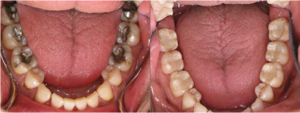INLAYS & ONLAYS
Cosmetic Dentistry
WHAT ARE INLAYS?
An inlay is an indirect restoration (filling) consisting of a solid substance (as gold or porcelain) fitted to a cavity in a tooth and cemented into place. Sometimes, a tooth is planned to be restored with an intracoronal restoration, but the decay or fracture is so extensive that a direct restoration, such as amalgam or composite, would compromise the structural integrity of the restored tooth or provide substandard opposition to occlusal (i.e., biting) forces. In such situations, an indirect gold or porcelain inlay restoration may be indicated. When an inlay is used, the tooth-to-restoration margin may be finished and polished to such a super-fine line of contact that recurrent decay will be all but impossible. While these restorations might be ten times the price of direct restorations, the superiority of an inlay in terms of resistance to occlusal forces, protection against recurrent decay, precision of fabrication, marginal integrity, proper contouring for gingival (tissue) health, and ease of cleansing offers an excellent alternative to the direct restoration.

WHAT ARE ONLAYS?
An onlay is the same as an inlay, except that it extends to replace a cusp. Crowns are onlays which completely cover all surfaces of a tooth. When a decay or fracture incorporate areas of a tooth that make amalgam or composite restorations inadequate, such as cuspal fracture or remaining tooth structure that undermines perimeter walls of a tooth, an onlay might be indicated. Similar to an inlay, an onlay is an indirect restoration which incorporates a cusp or cusps by covering or onlaying the missing cusps. All of the benefits of an inlay are present in the onlay restoration. The onlay allows for conservation of tooth structure when the only alternative is to totally eliminate cusps and perimeter walls for restoration with a crown. Just as inlays, onlays are fabricated outside of the mouth and are typically made out of gold or porcelain. Gold restorations have been around for many years and have an excellent track record. In recent years, newer types of porcelains have been developed that seem to rival the longevity of gold. If the onlay or inlay is made in a dental laboratory, a temporary is fabricated while the restoration is custom-made for the patient.
A return visit is then required to fit the final prosthesis.


 Open Chat
Open Chat

